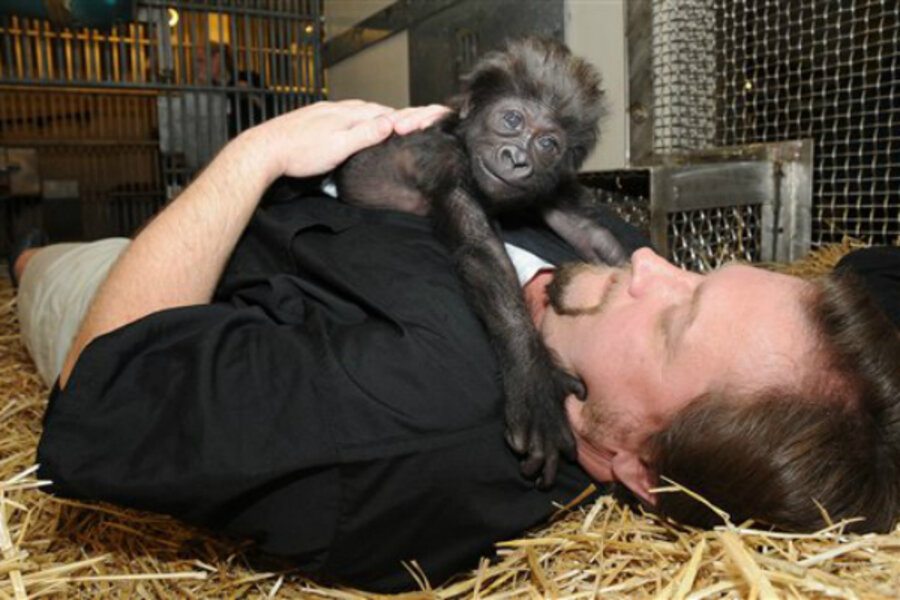Baby gorilla at Cincinnati Zoo has many mothers, some with moustaches
Loading...
| Cincinnati
Some zoo workers in Cincinnati are going ape over a baby gorilla.
They are wearing all-black outfits, grunting affectionately, and generally imitating mother gorillas to help the month-old baby adjust to a new home and get ready for a surrogate mother. Later, they will don hairy vests and carry baby Gladys on their backs, put on kneepads and gloves to move around like a gorilla, and they might knuckle-walk and climb a tree with baby on board.
Even though some of Gladys's mamas have beards and moustaches, they are trying to give her a mother's love, as much like a gorilla as they are able. They cuddle her, let her hang on them or squirm in their laps, lie down next to her, and talk to her with different guttural sounds.
"Whatever a gorilla mom would do with her baby is what we have to do with this baby," said Ron Evans, the zoo's primate team leader and one of Gladys's human surrogates. "Everything that we can do ... obviously, I'm not producing milk."
He's heading a team of seven to 10 people who work in shifts of eight hours or so to provide the baby with 24-hour companionship. She came from the Gladys Porter Zoo in Brownsville, Texas, where she was born Jan. 29 to a first-time mother who showed little maternal instinct. Zoo employees Jerry and Cindy Stones — the baby was named Gladys Stones on Friday — bottle-fed and cared for her there.
The zoos agreed it was best to move her to Cincinnati, where two experienced mother gorillas are available to serve as surrogates. Over the years, 48 gorillas have been successfully born live at Cincinnati.
Evans said the Columbus Zoo in Ohio has been a global pioneer in taking gorilla babies in need of surrogates from other zoos, but this is a first for Cincinnati. Zoo employees want to be careful, and have a four- to five-month transition period to make sure first that the baby is healthy, then will be able to socialize and be accepted within its population of eight other gorillas.
"We don't want to move too fast with her, where we stress out the baby," Evans said. "It's going to be a gradual process."
A suite has been set up for Gladys and the human surrogates, within view, hearing, and smell of the other gorillas. Evans said that so far, they have responded hospitably.
"Babies have a calming effect on a gorilla community," he said. "The two females were just fixated on that baby."
Gladys is gaining weight, big for her age at nearly seven pounds, and alert and apparently curious, looking around a lot at her surroundings.
When working on her transition plan, Evans considered bringing in veteran neonatal nurses, but decided that familiarity with gorilla behavior was more important. As the baby progresses, volunteers who have worked with gorillas may be added to help.
RECOMMENDED: Most popular pooches since 1880 (and cute photos!) — does your dog make the list?
Zoo spokeswoman Tiffany Barnes said the surrogate effort has drawn wide interest, with thousands of e-mails and social media responses already. There have been plenty of volunteers from the public to cuddle and bottle-feed the baby gorilla or otherwise help out.
"At this point, we aren't in need of volunteers, as we are using zoo staff members who have ape behavior knowledge and experience," she said. "That being said, if we ever needed volunteers, we know we don't have to look far."





